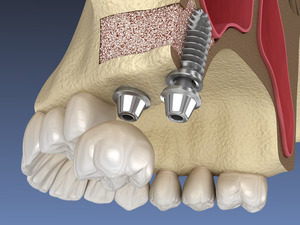
When you first visit your oral surgeon to ask about having dental implants placed, it’s important to keep in mind that they might suggest having preliminary work done first. One major example is a sinus lift. What exactly is this procedure, and why is it often a necessary part of the dental implant process? Here is what you need to know.
What Exactly is a Sinus Lift?
You may have already heard of bone grafting, which is a procedure where grafting material is added to areas of the jaw where bone density is lacking. A sinus lift is somewhat similar, but it involves an additional step: raising the sinus cavity. Not only does this help create room for the grafting material, but it also ensures that your sinus cavity won’t be in the way when it’s time to receive your dental implant posts.
When is a Sinus Lift Needed?
You may require a sinus lift if you are planning to have dental implants inserted in your upper jaw in order to replace your molars or premolars. Not every patient will have to undergo the procedure, but it may be necessary in the following situations:
- Significant bone loss has occurred in your upper jaw.
- Your upper jawbone has been significantly damaged in an accident.
- Your sinus cavity is unusually large, or your jawbone is relatively thin.
How Does a Sinus Lift Work?
The grafting material used for a sinus lift is typically bone tissue taken from elsewhere in your body. Some procedures may involve bone from a human or animal donor instead. In certain situations, synthetic grafting material may be utilized.
The actual sinus lift surgery involves opening your gums and creating a small opening in the bone. Said opening will allow your oral surgeon to lift the sinus cavity membrane and fill the space underneath it with the chosen grafting material. The surgery ends with the gums being sutured shut. For the sake of your comfort, your mouth will be numbed for the duration of your sinus lift.
Bear in mind that you’ll likely have to wait a few months to have dental implants placed after your sinus lift. The exact amount of time needed to recover from the procedure can vary from patient to patient, but rest assured that your oral surgeon will give you instructions to help make sure that the healing process goes as expected.
Thanks to sinus lifts, many patients can have dental implants placed in their upper jaws when they may not have been able to otherwise. Feel free to speak to your oral surgeon if you have additional questions about this procedure.
About the Author
Dr. Hasnain Shinwari initially studied dentistry at the University of Peshawar in Pakistan. Later in life, he moved to the United States and underwent additional training in Oral and Maxillofacial Surgery at Boston University. His Dumfries practice, Oral & Facial Surgery Center of Virginia, offers dental implant placement, sinus lifts, and various other advanced procedures. To schedule a consultation with Dr. Shinwari, visit his website or call (703) 574-4717.

